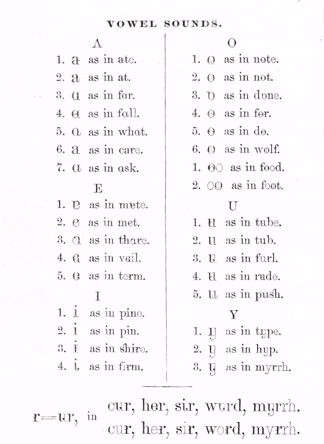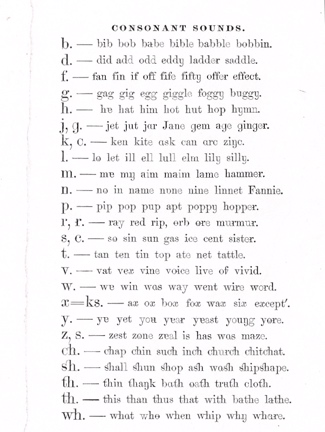 | |
Leigh Print | ||
Leigh Print was a self-pronouncing print successfully used as an Initial Teaching Alphabet (ITA) in the late 1800's. It allowed students to learn to read much faster than conventional reading methods. It was developed by Dr. Edwin Leigh, who spent 20 years designing and refining the system before its release in 1866. You can see the Leigh Print key below. A clearer version of the key and instructions on how to use the Leigh Print has been scanned by Dr. Earl Eugene Roth. He also scanned a copy of Leigh's filing with the Library of Congress, which includes interesting historical background about the print. A teacher that used the print in the late 1800's explains its use in a how to article that also is helpful for anyone teaching reading. Bowdoin College, Leigh's Alma Mater, has made several of his books available to view online through The Internet Archive: a good starting text, Hillard's Primer: edited in Pronouncing Orghography by Edwin Leigh; follow on books Franklin First Reader: edited in Pronouncing Orthography by Edwin Leigh, Franklin Second Reader: edited in Pronouncing Orthography by Edwin Leigh; and the Gospel: Gospel according to Saint Luke, edited in Pronouncing Orthography by Edwin Leigh, and Gospel according to Saint John, edited in Pronouncing Orthography by Edwin Leigh. Scanned copies of several textbooks that taught using Leigh Print and more details about Leigh Print are below the key. | ||
Leigh Key (Click here to see the key as a larger picture with better resolution.) | |
 |  | |
The First Reader | |||||
The American Educational Readers | |||||
The American Educational Readers | |||||
| LeighMonroe1R part 1 (1.6mB) | Leigh First Reader part 1 (1.1 mB) | Leigh Second Reader part 1 (2.7 mB) | |||
| LeighMonroe1R part 2 (2 mB) | Leigh Second Reader part 2 (3.5 mB) | ||||
| Leigh First Reader part 2 (1.2 mB) | |||||
| Leigh First Reader part 3 (1.4 mB) | Leigh Second Reader part 3 (3 mB) | ||||
| LeighMonroe1R part 3 (1.9 mB) | |||||
| LeighMonroe1R part 4 (2.2 mB) | Leigh First Reader part 4 (1.2 mB) | ||||
| Leigh Second Reader part 4 (2.8 mB) | |||||
Leigh also wrote a book for older German speakers to more easily learn to read and pronounce English. As a English speaking German language learner, I can attest that it also works as an aid to German language learning and pronunciation! It is called "The New Guide to Modern Conversation" and is available to view from Google Books. | |
Boston's 36 Annual Report of the Board of Education, 1873, page 168, states of Leigh's phonetic print, "We beg leave to say that six years of careful experiment in several schools in this city have shown the best results from this system....Within six months ordinary pupils under this system get nearly through the second reader; - a point which pupils by the old method are always eighteen months, and often two years in reaching. This is a constant, unvarying result." [1] In The Spelling Reform by Francis A. March (misspellings are intentional), Leigh Print is praised and explained on page 37, The following is an account of Leigh's system in St. Louis, by Hon. W. T. Harris, superintendent in St. Louis, 1868-1881: ...It is found to be a great saving of time to lorn to read by a fonetic alfabet first, and then change to the ordinary alfabet by degrees. The modified alfabet invented by Dr. Edwin Leigh has now been in use with us many years and stil give as great satisfaction as in the first years of its adoption....With this modified alfabet of Dr. Leigh wo find the following advantages : 1. Gain of time—a saving of one year out of the two years usually occupied in lerning to call off easy words at sight. 2. Distinct articulation, the removal of foren accent and of local and peculiar pronunciations. 3 According to the 1877 Annual Report of the School Committee of Boston, p. 57, of Dr. Leigh's print, "At the Vienna Exhibition the merit of his invention was recognized by the award of the Medal of Progress, — the highest grade of medal bestowed."[3] As Geraldine E. Rodgers explains in her History of Beginning Reading, page 516, In 1864, Edwin Leigh’s phonic pronouncing print appeared. Although it used the regular alphabet, the letters had special marks if needed to distinguish silent letters, variant vowel sounds, and so on. With letters already marked to show their variant sounds and all the vowel sounds, the Leigh method sidestepped the problems caused by not teaching children how to syllabicate words. That is because pronouncing vowels correctly automatically results in correctly dividing syllables. Teaching phonics, which had been abolished in America after 1826, was coming back in force in America in the late1860’s by the use of Leigh’s method. Yet it was coming back in a changed form: as the teaching of phonics on words instead of on syllables. By 1870, Leigh’s method was enormously successful all over the United States, particularly in Boston which had generally used the word method. Ferdinand Buisson of France visited the Centennial Exposition in Philadelphia in 1876 as an education representative of the French government, and while in America visited schools as well as the Exposition. In 1878, he wrote his Rapport Sur L’Instruction Primaire a L’Exposition Universelle de Philadelphie en 1876. In a footnote on page 232, in his chapter on reading instruction, he said: "Mr. Philbrick, after five years’ experience in the schools of Boston, wrote, in view of its (Leigh’s) striking results, ‘The word method must fall before the phonetic.’" [4] An 1866 article in "The Nation" told about the story behind Leigh print development and praised it, saying, The system commends itself on its face ; it is simple, easy, interesting, familiar. It is compatible with any mode of teaching, though here it is combined with that which employs words before single letters. We commend it to the teachers of primary schools and to the mothers of young children everywhere. If employed at the South, it would, we are persuaded, render the greatest assistance to the teachers of the freedmen, and shorten for the latter the interval (which it is so desirable to shorten) between them and the culture of civilization. [5] Unfortunately, Leigh Print was run out of the schools by advocates of Farnham's Sentence Method, a type of whole word method that focused on memorizing whole sentences. According to Rodgers, "It was Philbrick who told of the adamant opposition of “philosophers” by 1871 to Leigh print, as will be shown. Philbrick was fired as Boston superintendent in 1878, and Leigh print was effectively outlawed by the new curriculum only a few months later."[6] She further explains on page 561, It was Farnhams’ carefully placed 1873 paper in the widely read and widely respected NEA Journal that constituted the explosion that blew Leigh print off the American education map." [7] 1. Thirty-Sixth Annual Report of the Board of Education Together with the Thirty-Sixth Annual Report of the Secretary of the Board, January, 1873, p. 168, (There are two series of pages, it is the second page 168 in the Google scanned document.) 2. March, Francis, "The Spelling Reform," 1893, p. 37 3. Annual Report of the School Committee of Boston, 1877, 1878 (Report for year 1877, published in 1878), p. 57 4. Rodgers, Geraldine. "The History of Beginning Reading," 2001, p 516 5. The Nation. Hillard's Primer. 20 September, 1866. 6. Rodgers, Geraldine. "The History of Beginning Reading," 2001, p 537 7. Rodgers, Geraldine. "The History of Beginning Reading," 2001, p 561 | |